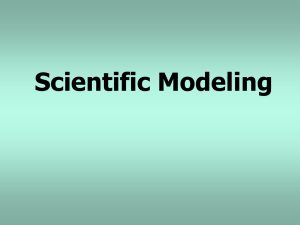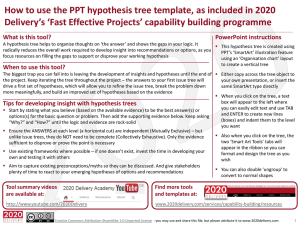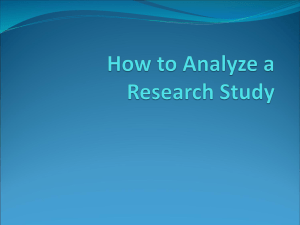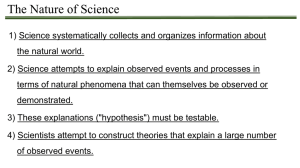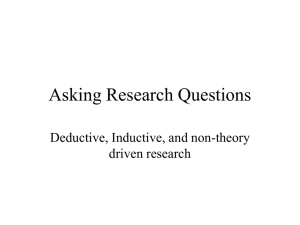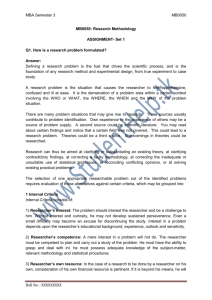Chapter 3 - Ramayah.com
advertisement
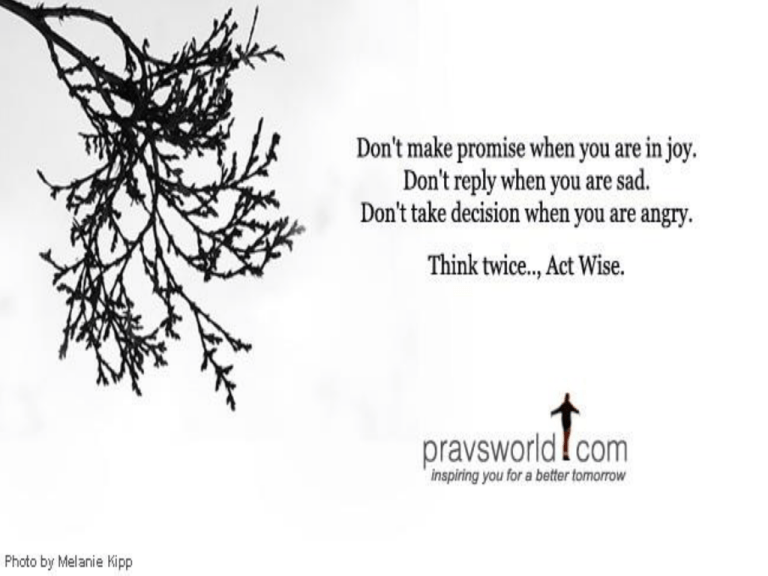
3-1 Thinking Like a Researcher 3-3 Learning Objectives Understand . . . • The terminology used by professional researchers employing scientific thinking. • What you need to formulate a solid research hypothesis. • The need for sound reasoning to enhance research results. 3-4 Research and Intuition “If we ignore supernatural inspiration, intuition is based on two things: experience and intelligence. The more experience I have with you, the more likely I am to encounter repetition of activities and situations that help me learn about you. The smarter I am, the more I can abstract from those experiences to find connections and patterns among them.” Jeffrey Bradshow, creator of the software that searches databases 3-5 Curiosity Is the Ally of a Researcher 3-6 Thinking Style Rationalism Postulate Self evident truth Authority Scientific Method Idealism Empiricism Literary Untested opinion Existentialism 3-7 Challenge for the researcher • The researcher must be able to identify source of quality information with the highest value which will bring the highest benefit and outcome for the decision being faced by the management 3-8 Sound Reasoning Types of Discourse Exposition Deduction Argument Induction 3-9 Inductive/Deductive Process Laws and Theories DEDUCTIVE INDUCTIVE Facts from Observation Explanation and Prediction 3-10 Induction and Deduction A B Observation/ Description Analysis C Explanation/ Hypothesis/ Theory 3-11 Deductive Theory Develop hypothesis Collect and Analyze data Accept/reject hypothesis 3-12 Inductive Develop Theory Formulate Relationship Analyze patterns & themes Observe phenomenon 3-13 Language of Research Concepts Constructs Models Terms used in research Theory Conceptual schemes Operational definitions Variables Propositions/ Hypotheses 3-14 Language of Research (Concept) Success of Research Clear conceptualization of concepts Shared understanding of concepts • A Concept is a generally accepted collection of meanings or characteristics associated with certain objects or events. • Concepts have evolved over time through shared usage. • A Construct is an image or abstract idea specifically invented for a given research and/or theory building purpose 3-15 Job Redesign Constructs and Concepts 3-16 Operational Definitions How can we define the variable “class level of students”? • • • • Freshman Sophomore Junior Senior • • • • < 30 credit hours 30-50 credit hours 60-89 credit hours > 90 credit hours 3-17 Example Concept Definition Operationalization Organizational A situation where the individual Commitment feels satisfied with the organization and its goal and would like to remain affiliated to achieve that goal Questionnaire Score Organizational Commitment (Mowday, Steers & Porter, 1979) Job Satisfaction The attitude of a person towards work, as a result oh his/her perception about the fit between him/her and the organization Questionnaire Score Job Diagnostic Survey (JDS) (Hackman & Oldham, 1975) Perceived Usefulness A person’s subjective evaluation Questionnaire Score PU of the extent of using a system (Davis et al., 1989) would enhance the individual’s job performance 3-18 A Variable Is the Property Being Studied Act Event Variable Characteristic Trait Attribute 3-19 Types of Variables Dichotomous Male/Female Employed/ Unemployed Discrete Ethnic background Educational level Religious affiliation Continuous Income Temperature Age 3-20 Types of Variables • Independent • Dependent • Moderating • Mediating • Control Independent and Dependent Variable Synonyms Independent Variable (IV) • Predictor • Presumed cause • Stimulus • Predicted from… • Antecedent • Manipulated • • • • • • Dependent Variable (DV) Criterion Presumed effect Response Predicted to…. Consequence Measured outcome 3-21 3-22 Exercise 1 • A manager believes that good supervision and training will increase the production level of the workers. 3-23 Exercise 2 • A manager finds that off-the-job training has a great impact on the productivity of the employees in his department. However, he also observes that employees above 50 years do not seem to derive much benefit and do not improve from such a training. 3-24 Exercise 3 • The manager of the ABC Company observes that the morale of employees in her company is low. She thinks that if the working conditions, pay scales, and the vacation benefits of the employees are bettered, the morale will improve. She doubts, though, that the pay scales are going to raise morale of all employees. Her guess is that those who have good side incomes will be happy with the increased pay and their morale will improve. 3-25 Exercise 4 • The manager of AS International was worried with the high absenteeism among his workers on Monday mornings. He thinks that employees who consume excessive alcohol over the weekend experience hangover on Monday morning and will not come to work. He also feels that the high wages allows the employees to become lethargic. During his informal chat with the workers he found that all the workers in the factory consume alcohol during the weekend. Also, during the chat some workers told him that some will not experience hangover because they have high levels of tolerance towards alcohol. “Ha!, Now I know” the manager said “only those with a low level of alcohol tolerance will experience hangover thus absent from work on Mondays. Besides that the high wages could be another reason why this phenomenon happens. 3-26 Exercise 5 • A marketing manager would like to predict the factors that influence purchase decision. He conducts a literature search and also interview with several clients. After going through this process he forwards this suggestion: • When the product is of high quality, the confidence towards the product will increase and this will lead to higher purchase intention. He also found that when the price is low, the intention to purchase will also increase. If the brand of the product is more known then the purchase intention will also increase. However he also found that if the client has high brand loyalty for a different brand than the one marketed by the company, then the brand knowledge does not play an important role in the intention to purchase. 3-27 Propositions and Hypotheses Concept A Concept B (Reinforcement) (Habits) Hypotheses at the Empirical Level Bonus RM for Sales exceeding quota Make more than 4 sales calls a day 3-28 Hypothesis Formats Descriptive Hypothesis • In Penang, our potato chip market share stands at 13.7%. • Malaysian cities are experiencing budget difficulties. Research Question • What is the market share for our potato chips in Penang? • Are Malaysian cities experiencing budget difficulties? 3-29 Relational Hypotheses Correlational Causal • Young women (under 35) purchase fewer units of our product than women who are older than 35. • An increase in family income leads to an increase in the percentage of income saved. • Loyalty to a grocery store increases the probability of purchasing that store’s private brand products. • The number of suits sold varies directly with the level of the business cycle. 3-30 The Role of Hypotheses Guide the direction of the study Identify relevant facts Suggest most appropriate research design Provide framework for organizing resulting conclusions 3-31 Role • Husbands and wives agree in their perception about each person’s role in the decision making process of household buying 3-32 Characteristics of Strong Hypotheses Adequate A Strong Hypothesis Is Testable Better than rivals 3-33 Hypothesis 3-34 Theory • A set of concepts, definition and propositions that are inter related systematically which is forwarded to explain or predict a phenomenon 3-35 Value of theory to research • Reduces the range of facts that needs to be researched • Summarizes what is already known about the object of the research • Is used to predict other facts that needs to be found 3-36 Theory of Reasoned Action (TRA, 1980) and Theory of Planned Behavior (TPB, 1991) 3-37 Model • The presentation of a system that is developed to study part of the system or the whole system of relationship • The difference between theory and model is that the role of theory is for explanation whereas the role of the model is for representation 3-38 Multi Attribute Attitude Model (1973) Attributes • Attrib1 • Attrib2 • Attrib3 • Attrib4 • Attrib5 • Attrib6 • Attrib7 • Attrib8 • Attrib9 • Attrib10 • Attrib11 • Attrib12 • Attrib13 Credit Card Usage 3-39 Conceptual Schemes • Conceptual schemes is how a researcher formulates the relationship between the factors identified as important in the study of the problem formulated from: • Past studies • Logic and belief Helps in the testing and understanding of the variables 3-40 Example – Conceptual Scheme Self Efficacy Perceived Usefulness Perceived Ease of Use Organizational Support Computer Experience Internet Usage 3-41 Developing Conceptual Schemes Identify the Concepts Define the Concepts Operationalization of the concepts Explore the relationship between concepts 3-42 Characteristics of a Good Conceptual Scheme • Important variables must be identified and labeled • Explain the relationship between 2 or more variables based on some theory • If there are prior research, the relationship, either + or – must be posited • Must also be able to explain why such relationship exists • A schematic diagram should be presented so that readers can better visualize the relationship 3-43 What is Important in this Chapter? • Thinking Styles • Inductive vs Deductive Thinking • Language of Research • • • • • • • • Concept Construct Definition Variable Proposition and Hypothesis Theory Model Conceptual Schemes




